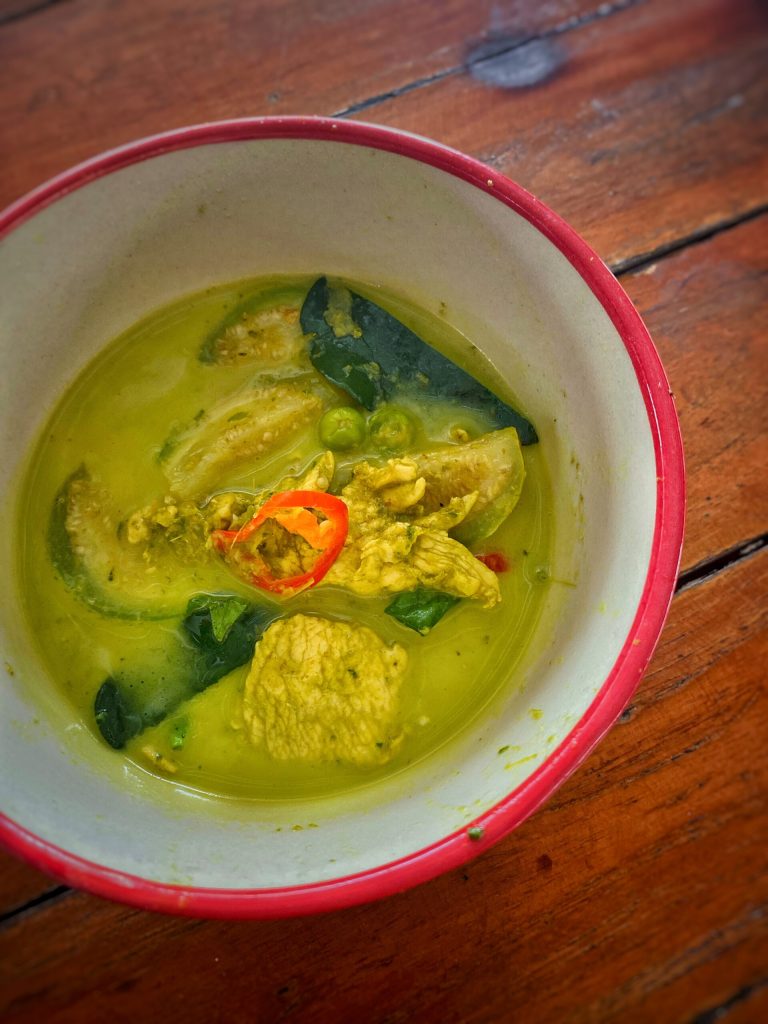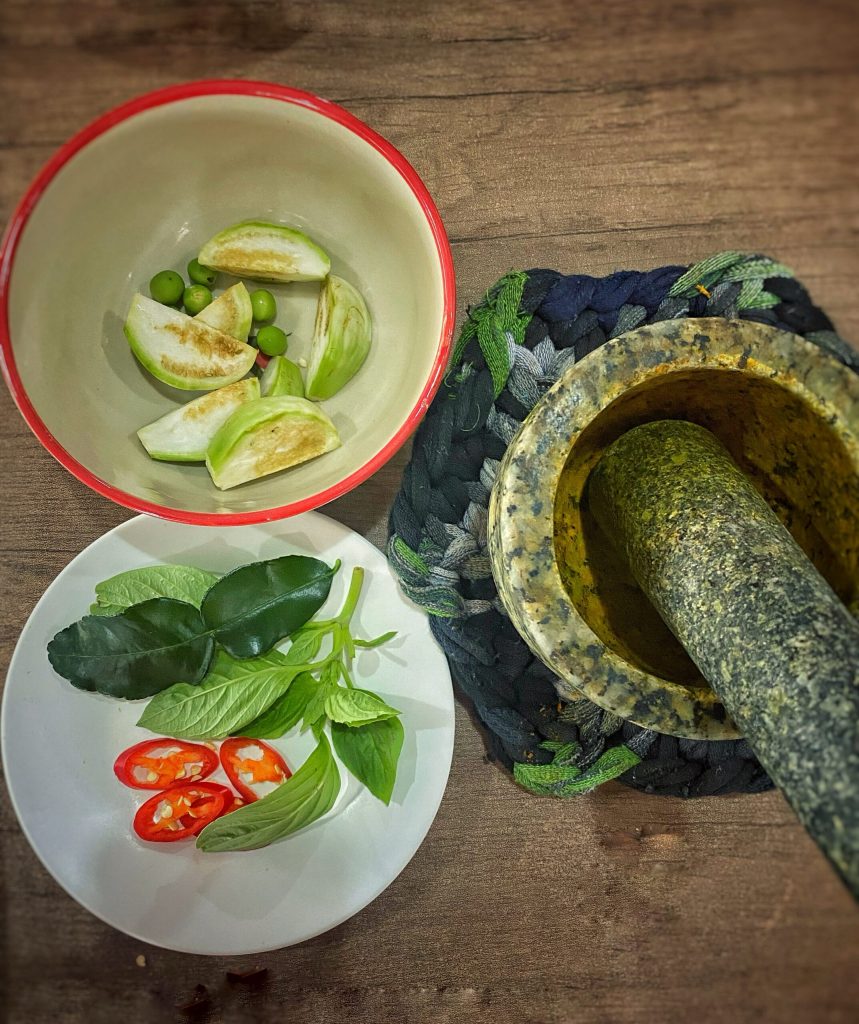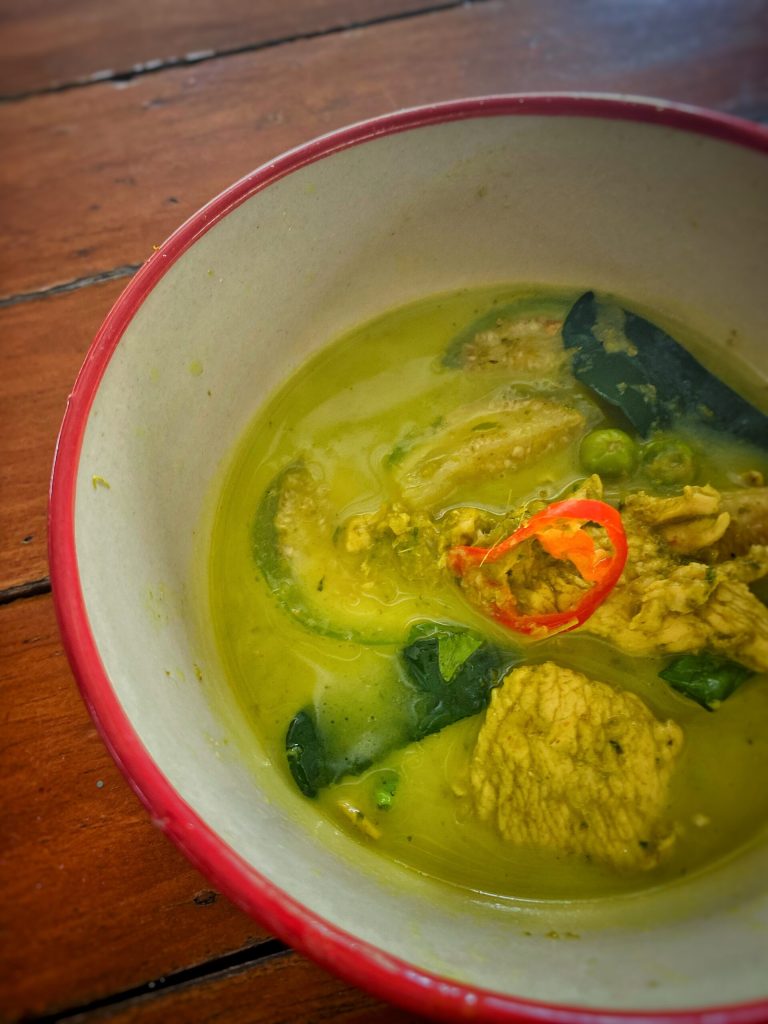Kaeng khiaw-waan is a classic Thai dish. Outside Thailand, it is known as Thai Green Curry, Green Curry.
The green color of the dish comes from the ingredients, which are almost exclusively green.
Kaeng means “curry”,
khiao means “green”
wan means “sweet”.
But the dish is not sweet, but spicy like all Thai kaeng. Wan can also mean “mild, gentle, weak” in a figurative sense, so Khiao Wan can be understood as “gentle green”.
To create the curry paste (Khrueang Kaeng), the real heart of any Thai curry, every family has a mortar (Thai: ครก), which should preferably be made of solid stone.
Here the ingredients are crushed, ground, and mashed with a pestle (Thai: สาก) until they combine into an aromatic, homogeneous, and thick mass where no leaf is seen anymore.
The basic ingredients of curry paste are the same for every type of curry, what changes is the element or elements that give the color, and for Kaeng khiaw-waan, they are: fresh green chilies (Phrik Khi Nu), Thai basil (Thai: ใบโหระพา – Bai Horapa (or Horapha), Ocimum basilicum), green, and Thai eggplants (Makhuea Pro), which are instead small and white.
With the addition of a protein, usually fish, but also chicken (gai or kai) as in this case: Kaeng Khiaw Waan Gai.
This version was made during my Thai cooking course in Ao Nang, an experience booked through GetYouGuide, in the first part of my trip to Thailand in October 2024 (see video), like the recipe for the:

- Difficulty: Medium
- Cost: Cheap
- Preparation time: 20 Minutes
- Portions: 2 People
- Cooking methods: Boiling
- Cuisine: Thai
- Seasonality: All seasons
Ingredients
- 7 green chilies (fresh)
- 2 cloves garlic
- 1 shallot
- 1 stalk lemongrass
- 1 tablespoon galangal (chopped)
- 2 leaves kaffir lime
- 1/2 tablespoon black peppercorns
- 2 teaspoons coriander seeds (toasted)
- 1 teaspoon cumin seeds (toasted)
- 1/2 teaspoon shrimp paste
- to taste Thai basil
- 3.5 oz chicken breast
- 2 oz Thai eggplants
- 6 Thai eggplant seeds
- 4 leaves keffir lime
- to taste Thai basil
- 1 cup ml coconut milk
- 2 tablespoons palm sugar
- 2 tablespoons fish sauce
- to taste vegetable oil
- 2 red chilies
Steps
Vigorously crush the peppercorns with coriander and cumin seeds first, then add the other ingredients until forming a compact paste where the leaves are no longer visible.

In a wok, fry the oil over low heat.
Add the green curry paste, a bit of coconut milk, then the chicken breast pieces and mix.
Add the rest of the coconut milk, quartered eggplants, the keffir leaves, and eggplant seeds.
Adjust with sugar and fish sauce. Finally, add Thai basil leaves and chopped red chilies.

This is the recipe from the Thai cooking course pantry that you can download for free and where you will also find various information about Thai cuisine and many other traditional recipes, such as the papaya salad, som tam.
This is the recipe from the Thai cooking course pantry that you can download for free and where you will also find various information about Thai cuisine and many other traditional recipes, such as the papaya salad, som tam.
FAQ (Questions and Answers)
What is the difference between kaeng and masala? Between Thai and Indian curry?
The fundamental difference from Indian curry is that the group of Thai “kaeng dishes” is not made up of ground spices, but of a curry paste, called Khrueang Kaeng.
Moreover, the spices are not first fried in fat, as in India, but the paste is often cooked in coconut milk.The fundamental difference from Indian curry is that the group of Thai “kaeng dishes” is not made up of ground spices, but of a curry paste, called Khrueang Kaeng.
Moreover, the spices are not first fried in fat, as in India, but the paste is often cooked in coconut milk.When did Kaeng khiaw-waan first appear in Thai cuisine?
Green curry evolved during the reign of King Rama VI and Rama VII at the end of the century.
Between the years 1908-1926. There is no mention of it in the authoritative multi-volume cookbook Plean Passakornrawong of 1908.
Green curry can be found for the first time in the 1926 cookbook by Lor. Phaehtraarat.Green curry evolved during the reign of King Rama VI and Rama VII at the end of the century.
Between the years 1908-1926. There is no mention of it in the authoritative multi-volume cookbook Plean Passakornrawong of 1908.
Green curry can be found for the first time in the 1926 cookbook by Lor. Phaehtraarat.What are the ingredients for Khrueang Kaeng (curry paste)?
Chili
Garlic (Thai: กระเทียม – Kratiem),
Shallot (Thai: หัวหอม – Hua Hom),
Galangal root (Thai: ข่า – Kha),
Toasted coriander seeds (Thai: เม็ดผักชี – Met Phak Chi)
Coriander root (Thai: รากผักชี – Raak Phak Chi)
Kaffir lime peel (Thai: มะกรูด – Makrut)
Lemongrass (Thai: ตะไคร้ – Ta-Khrai)
Shrimp paste (Thai: กะปิ – Kapi)
Chili
Garlic (Thai: กระเทียม – Kratiem),
Shallot (Thai: หัวหอม – Hua Hom),
Galangal root (Thai: ข่า – Kha),
Toasted coriander seeds (Thai: เม็ดผักชี – Met Phak Chi)
Coriander root (Thai: รากผักชี – Raak Phak Chi)
Kaffir lime peel (Thai: มะกรูด – Makrut)
Lemongrass (Thai: ตะไคร้ – Ta-Khrai)
Shrimp paste (Thai: กะปิ – Kapi)

